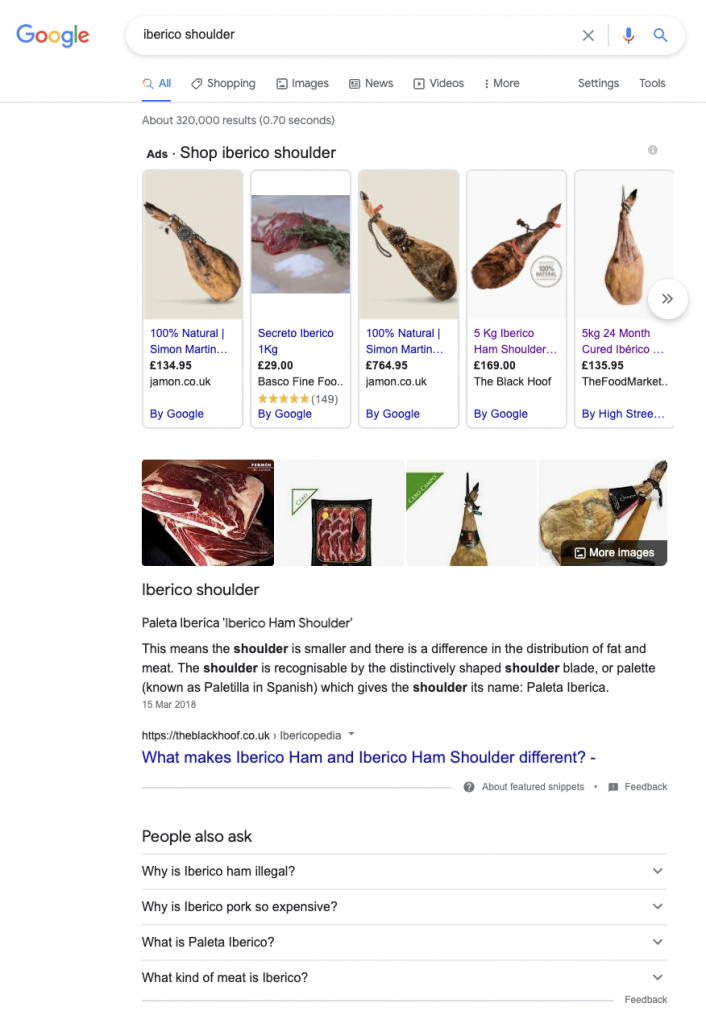This guide will go through the following:
- What is Search Intent
- How Search Intent affects Paid Search
- Signals of Search Intent
- Methods for aligning search intent (search query modifiers, TF-IDF, and more)
- Our Syntent API
- Multilingual, multi country campaigns
- Changing market trends
- The value of getting search intent right
What is Search Intent?
Search intent from a search engine marketing standpoint is the thought behind the search query. So while users of Google and other search engines type in different phrases and keyword variations, to invariably find that same something online. That same something is the search intent behind the search query. Some examples to illustrate search intent.
“Pot-ay-to, Pot-ah-to”
The word potato (as well as tomato) is said differently, yet they mean the same thing. If only search queries were that easy. Your customers have different ways of expressing what they’re looking for.
For example, take “womens trench coats” and “trench coats”, while the latter could quite easily include men, the chances are most people searching for trench coats are women. So you’d want to map both search queries to the women’s trench coat landing page.
Let’s take another example, “funeral insurance” and “funeral savings plans” they both could appear to be different products. Again, apart from the word funeral, in any other contexts, insurance (car, home) and savings plans (ISAs, high interest bank accounts) would not have the same landing page content let alone the same intent. For some reason, funeral insurance and savings plans mean the same thing and would make sense to be mapped to the same landing page.
How Search Intent affects Paid Search
A little context. The well known pillars of the Google quality score are:
- Keyword
- Landing Page
- Max Bids
And while best practice Google Ads accounts are structured for 1 keyword per Ad Group. What the searcher on Google is thinking when they type in those keywords remains an enigma. So what are the signals of search intent?
Signals of Search Intent
So it’s now agreed, if it wasn’t already that search intent is highly relevant and important to Paid Search performance. So how do we go about understanding the search intent of a keyword or search query?
SERP Features
The first signal would be to see what features or types of results Google is displaying. Examples are given below for the major types of search intent:
- Information intent would be indicated by one of or a combination of p-zero, Google answer box, FAQ results as the search queries are encyclopedic in nature e.g. “President of America”
- Commercial intent could be indicated by a mixture of Shopping results combined with Google FAQ results because a transaction is possible e.g. “compare chef knives”
- Transactional intent would be indicated by Shopping results because a transaction is possible e.g. “big green egg bbq”
- Navigational intent searches are usually brands or website names where the user knows which site they wish to visit but are uncertain of the URL. One indication could be a knowledge graph box result in addition to the website with sitelinks displayed as part of the first ranked result.
Search Query Modifiers
The modifiers in themselves are clues. Some examples are given below:
- Information: how, what, why, where, when, guide, tips
- Commercial: compare, review, best, top
- Transactional: buy, deal, discount, sale, cheap, price
- Navigational: [none as it’s brand name driven]
Methods for aligning search intent
Okay so we know the main types intent and some of the inferences that can help us but are the main main
Search Query Modifiers
This is basically a string detection exercise i.e. if these list of words is in the search phrase then classify the search phrase as ‘commercial’. A python script for example might look like.
def which_search(search_string): Information = [how, what, why, where, when, guide, tips] Commercial = [compare, review, best, top] Transactional = [buy, deal, discount, sale, cheap, price] if any(map(lambda x: search_string in x, Information)): search_intent = 'Information' elif any(map(lambda x: search_string in x, Commercial)): search_intent = 'Commerical' elif any(map(lambda x: search_string in x, Transactional)): search_intent = 'Transactional' else: search_intent = 'Navigational' return Search_intent
The above takes the search string and then detects the words in lists defined in the function.
That’s all very well assuming you’re able to capture all of the anticipated modifiers in your script. Afterall, any modifiers not predefined will end up being defined as navigational.
What if you’re working on a multilingual campaign? Imagine having to create rules for these in every language.
What about search strings like “what are the best laptops”?
Is this information or commercial? According the function it would be commercial as the logic in the above function would overwrite the intent from Information to Commercial.
TF-IDF
Which stands for Term Frequency – Inverted Document Frequency, TF-IDF multiplies the count of most repeated words (TF) in a web page for a given word, and the inverse proportion of web pages containing said word within the website (IDF). For example, it will look at the word “bbq” and compare it to other pages.
The result is a weighting showing the words importance for a given web page.
SEO software attempts to solve search intent, by helping users map new keywords to existing pages, using TF-IDF. This would work by seeing which web page has the highest TF-IDF score for that proposed search query and therefore recommending the mapping. So if you’ve decide
A number of advantages include the fact that it can be used across many different languages and that it’s very easy to scale.
The downside with this approach is that it doesn’t take into account what the user or the market thinks about a product or whatever it is searching for.
For example, you may have a furniture store and a page on coffee tables. Then from your keyword research, you decide that “side table” would be a good search term to optimise for.
The problem there is that using TF-IDF, you’re likely to be recommended creating a new landing page as the word “coffee” and “side” have nothing in common from a pure mathematical perspective.
Landing Page Content and Search Results
This approach is a bit more complex, however the signals are much clearer when it comes to search intent. Let’s cover these in turn:
Landing Page Content
This provides a great number of clues as to what content your landing pages have in order to satisfy the search engine query. Therefore does it not stand to reason that this is a rich source of intel as to which landing pages are best matched to search queries?
Using neural networks, AI can make the connection between landing pages (from different website) to see what content themes are common and therefore arrive at a conclusion as to what keywords are a good match.
Search Results
They tell us a bit more about the user state of mind. For example, take the search query ‘iberico shoulder’, the search engine results are shown below:

Although there’s no ‘buy’ or ‘for sale’ in the search modifier, it’s quite clear that Google has deduced with its Bayesian reasoning that some people want to buy the food (Transaction – as shown by the Google Shopping results) while others want to know more about it (Information – show by the FAQ box).
This is why it’s not beneficial to use the popular SEO industry categorisation because the intentions are mixed.
Thus it would make sense to map both keywords to the same landing page – even if they’re in different Ad Groups. One Ad Group would have copy for information, the other for a buyer offer, with both leading to the same destination URL with content covering shoulders for sale and some info explaining what it is etc.
Our Syntent API. Your better Search.
The Landing Page Content and Search Results method is how our Syntent API works.
All you do is supply our API the keywords (with language and country), within minutes, our models will make sense of their content and context, grouping them by search intent.
We’ll also name these groups by the highest search volume ‘query’ and return you the list using our API.
Why is this such a good approach?
Languages. Cultures.
It’s not enough to engineer models for different languages, because people think and do things differently despite their common language. For example, an American living in the USA searching for ‘rubbers’ will most certainly have a very different intention to an English person using the very same search query!
Using the API, we cover most major languages and countries so that you can achieve near perfection when it comes to structuring your keyword landing page combinations and suggested keywords.
Markets change. Intentions change.
Of course the world changes, as do your users. A Google search for ‘braces’ in the UK 20 years ago would have shown results for both trouser braces and dental braces. Now virtually all the results on Page 1 show dental braces.
That’s why it’s important to evaluate the search intent of your keywords every time there’s a Google Core update. Not only is it useful to SEOs, it’s useful for paid search.
What is cost-effective high value search worth to you?
Imagine if you could structure your ad accounts according to the keyword landing page combinations your user would expect, in addition to knowing which landing pages are likely to succeed for new keyword ideas?
Check out our Syntent API here.
